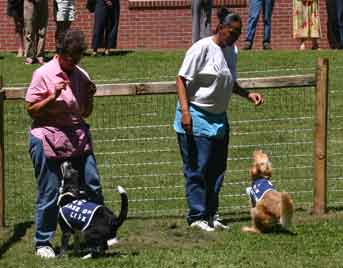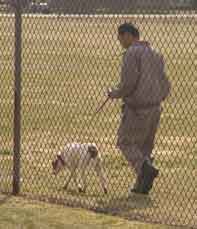|
N.C. inmates, dogs take new 'leash'
on life with training program
DAN KANE
Associated Press
TILLERY, N.C.
- A Halifax County deputy found Bob, a black Labrador
mix, on a back road a year ago when he was a pup just a few
weeks old. He and two other male pups were starving in the wild,
surviving by dining on their dead mother. The deputy took them
to a volunteer-run shelter in the county.
Durham County deputies found Kenneth Harris near Bahama,
where he had stolen lumber from a construction site. The
deputies chased the small-time crack dealer to a housing
project, where he turned himself in. He was sentenced in 2002 to
more than eight years in prison under the state's four-strikes
law.
During the course of two months this year, Harris and Bob
helped each other on a path out of confinement, even though it
was a path that would eventually lead them apart. They were
among the first dog-inmate teams to participate in Caledonia
Correctional Institution's "A New Leash on Life" program. Harris
learned to train Bob to be a well-behaved pet that could be
readily adopted, instead of destroyed in an overcrowded shelter.
Bob provided Harris with a way to make his time in prison
productive and rewarding, teaching him a new skill that he might
turn into a career when he leaves prison.
State Department of Correction officials call the program a
"four-way win."
The community gets trained pets, the prison keeps inmates
productive, the inmates learn a new skill, and as Fay Lassiter,
the assistant chief of program services for the Correction
Department, put it: "The dog's sentence is commuted to life."
A Dominican nun started the first prison dog training program
in Washington state nearly 25 years ago. Since then, several
states have launched them, including North Carolina a year ago.
The Correction Department has found homes for 42 of the 44 dogs
in the program. Only two have failed to complete it. Leash on
Life operates out of six prisons - four are minimum security,
while Caledonia and Craven Correctional Institution are medium
security.
Harris, 43, volunteered for the program as soon as he learned
about it. He had trained dozens of beagles to hunt while growing
up in northern Durham County, and had left several of them in
the care of his cousin.
Prison officials looked at his record and saw he was a
nonviolent criminal with good behavior behind bars and no
history of deviant acts. Harris couldn't believe his good
fortune - he would spend his days training dogs simple
obedience, instead of taking a kitchen job or toiling in the
cannery for vegetables grown on Caledonia's prison farm.
But there was one catch that Harris learned as the weeks went
by: After taking care of Bob and training him to sit, to stay
and to come running on a sharp whistle, Harris was going to have
to let him go.
Bill Carroll, the program director for Caledonia, knew that
was no simple matter. Midway through the program, Carroll
watched Harris let Bob run loose on an unusually warm morning in
February.
Bob took off after the other two dogs in the training program
- Judy, a German shepherd mix, and Denise, a hound mix - and
they chased and nipped at each other in reckless glee. But then
Bob stopped in mid-run, plunked down in center field and looked
at Harris. His playful brown eyes and happy-go-lucky grin said
it all.
Harris walked to the dog, lay down on the grass and rested
his head on Bob's hips as if the dog were a pillow. Carroll
pulled out his camera and took a photo. What better way to
advertise the program? he thought.
That afternoon, though, he thought about the scene
differently. "I know it's going to be hard on the inmates,
giving them up," Carroll said.
Harris and the five other inmates in the program began each
morning feeding and walking the dogs before putting them through
their obedience lessons. The dogs first learned to walk on a
leash alongside their trainers, then to sit and to stay. Next,
they learned to "place," which means go to a designated
location. Each command took about a week and a half for the dogs
to learn.
Greg Richardson, a Halifax County sheriff's deputy who works
with the K-9 unit, trained the inmates. He taught them hand
signals to use for the commands, such as a closed fist for stay.
One day, Richardson watched the dogs as the inmates walked
them roughly 20 paces between two cones. It appeared that the
dogs, as they walked alongside the inmates, were listening to
the commands. But Richardson realized the dogs were merely
counting their steps so they would round the cones with their
trainers. That wouldn't work in the real world, Richardson told
the inmates. That's why they had to change their routines, so
the dogs paid attention to the commands.
Bob had a quirk that Harris needed to correct. The dog was so
used to living in a kennel from his days in the shelter that he
often ran back to it, particularly if Judy and Denise were
there. One day Bob ran back to the kennel twice after Harris
tried to get him to place on a small platform in the prison
yard.
Harris and the other inmates took copious notes about what
they and the dogs learned. They filled out journals that would
go to the future owners so they would have a better
understanding of their pets.
"He's going to be a real good dog to have," Harris wrote
neatly in the journal after one training session. He called Bob
his "old bigheaded boy" and told him he had to do well during
their daily walks so they'd both succeed.
When graduation came, it went just as the program started,
with an official event in the prison gymnasium. The prison
choir, augmented by bass and keyboard, sang old gospel standards
to a crowd of prison officials, local dignitaries and several
volunteers from the Down East Animal Refuge in Scotland Neck.
The prison cafeteria dished up roast beef and turkey with green
beans and mashed potatoes.
It was a day to advertise the good work of the six inmate dog
trainers, prison staff and Richardson, and to get the message
out that there were strays who needed homes. Rain leaked through
several cracks in the aging building's roof and collected in
buckets along a wall lined with weight benches.
As Harris waited for the show to begin, someone asked him
what he had learned from the program. Patience and
responsibility, he said.
Harris and inmate Dennis Johnson, who trained Judy, showed
the audience the dogs' achievements. Bob and Judy walked
alongside their trainers, sat and placed on command. Johnson had
taught Judy to jump through a hoop, which she did several times.
(Denise, the third dog, missed the graduation; she had been
claimed by her new owner a week earlier.)
Several volunteers from the shelter dabbed tears from their
eyes. They knew the dogs had been successfully rescued.
Judy went to a young couple in the county, while Bob went to
the father of Lawrence Solomon, superintendent at nearby Odom
Correctional Institution. Solomon's father was not at the
graduation, so Harris tried to tell Solomon how to care for Bob.
"He's strictly a one-man dog," Harris told Solomon. "It's
going to take about two weeks before he'll do anything."
"I'll let you know how he's doing," Solomon said.
He told Solomon that he'll come take care of Bob after he
gets out of prison in five years, if Solomon would like.
A short time later, Carroll introduced three new dogs to the
training program. It was his way of getting Harris, Johnson and
the other inmates to think beyond Bob, Judy and Denise. Harris
didn't pay attention to the new dogs. He had one more thing to
tell Solomon about Bob.
It's his secret to gaining Bob's trust. He reaches down and
scratches a spot on the side of Bob's neck. Bob turns his head
counterclockwise, and his eyes go unfocused in pure bliss.
"When he turns his head that way, you got it," Harris said.
But Solomon didn't try to scratch Bob, who was skittish
around him. Solomon walked away to go back to work.
Someone would come by later to pick up Bob. Harris stepped
back and turned his stocky, 5-foot-9 frame away from those
around him. He grabbed a handkerchief in a hand big enough to
palm a basketball in mid-dribble. Then he wiped at his eyes.
|
 DOWN
EAST ANIMAL REFUGE
DOWN
EAST ANIMAL REFUGE  DOWN
EAST ANIMAL REFUGE
DOWN
EAST ANIMAL REFUGE  Down East Animal Refuge (DEAR) is
pleased to announce a partnership with Caledonia Prison in a pilot program
called " A New Leash on Life". First piloted at Marion Minimum Security Unit
and Black Mountain Correctional Center for Women, the program pairs inmate
trainers with local shelter dogs for at least six weeks, teaching basic
obedience, house training and socialization.
Down East Animal Refuge (DEAR) is
pleased to announce a partnership with Caledonia Prison in a pilot program
called " A New Leash on Life". First piloted at Marion Minimum Security Unit
and Black Mountain Correctional Center for Women, the program pairs inmate
trainers with local shelter dogs for at least six weeks, teaching basic
obedience, house training and socialization.  These dogs will be available for
adoption at the end of the 6-8 week program. If anyone is interested in one of
these dogs, please contact any member of DEAR. Not only will these dogs have had
all their shots and been either spayed or neutered but now, will have had basic
obedience training.
These dogs will be available for
adoption at the end of the 6-8 week program. If anyone is interested in one of
these dogs, please contact any member of DEAR. Not only will these dogs have had
all their shots and been either spayed or neutered but now, will have had basic
obedience training. ![]() North Carolina
Department of Prisons "New Leash on Life" web Site
North Carolina
Department of Prisons "New Leash on Life" web Site![]() North Carolina Department of Prisons Press Release on "New Leash on Life"
Program
North Carolina Department of Prisons Press Release on "New Leash on Life"
Program